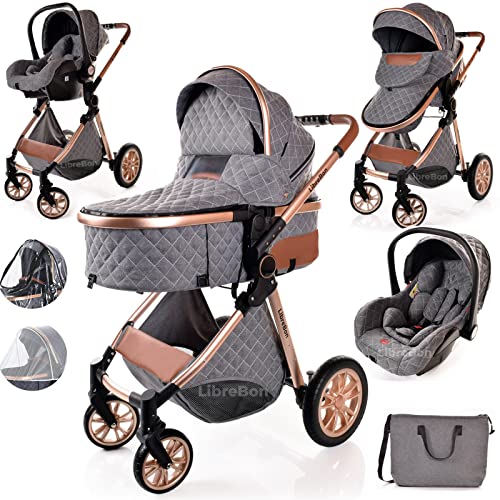Understanding Prams and Pushchairs: A Comprehensive Guide
When entering the world of being a parent, one of the most important decisions to make includes picking the ideal equipment for transporting a newborn or toddler. Amongst the top competitors for this purpose are prams and pushchairs. Both serve the essential function of helping parents and caregivers carry their kids easily, however they have unique features, advantages, and utilize cases that set them apart. This short article aims to explore prams and pushchairs in-depth, assisting potential purchasers through their important distinctions, advantages, and functions, and resolving regularly asked concerns.
What is a Pram?
A pram, brief for "perambulator," is a type of automobile designed particularly for babies. It includes a fully reclining seat or bassinet, so a baby can lie flat while being carried. This is particularly essential for newborns whose spines are still developing. Prams typically have larger wheels, offering a smoother ride on various surfaces.
Key Features of Prams:
- Fully Reclining Seat: Allowing babies to lie flat.
- Bassinet Design: Some models feature a detachable bassinet.
- Roomy Interior: Adequate space for the child to move easily.
- Robust Frame: Designed to be more steady, ideally fit for urban and rural locations.
Advantages of Prams:
- Comfort: Provide a comfortable area for the baby.
- Versatility: Many can be transformed to a pushchair as the kid grows.
- Stability: Larger wheels and frames offer greater stability, especially on uneven surface.
What is a Pushchair?
A pushchair is a light-weight alternative often utilized for young children. Unlike prams, pushchairs normally feature a seat that can sit upright and may not offer a completely reclining option, making them appropriate for older babies who can support their heads and necks. Most contemporary pushchairs come with different features geared towards convenience for the moms and dad and convenience for the kid.
Secret Features of Pushchairs:
- Multi-position Seats: Can accommodate sitting upright or reclining alternatives.
- Light-weight Design: Easier to bring and maneuver.
- Foldable Framework: Often fold compactly for easy storage and transport.
- Larger Storage Baskets: Convenient for bring baby fundamentals.
Benefits of Pushchairs:
- Lightweight and Portability: Easy to transfer and save.
- Steerability: Smaller wheels allow sharper turns.
- Ease of access: Easier access to older toddlers.
Secret Differences Between Prams and Pushchairs
| Feature | Pram | Pushchair |
|---|---|---|
| Age Recommendation | Newborn to 6 months | 6 months to 4 years |
| Seat Position | Completely reclined | Multi-position |
| Weight | Heavier | Lightweight |
| Surface Usage | Appropriate for all terrains | Best for city/urban environments |
| Size | Larger, bulkier | Compact, easy to fold |
Choosing the Right Option for Your Needs
The choice to pick between a pram and a pushchair mostly depends upon your specific lifestyle and your kid's age. Here is a breakdown of considerations to assist narrow down the options:
Considerations for Prams:
- If you live in a backwoods with rough terrain, a sturdy pram might be better.
- If you plan to utilize it for long walks or trips, the comfort of a pram can be helpful.
- Ideal for moms and dads who desire a model that will comfortably support a newborn.
Factors to consider for Pushchairs:
- If you require something lightweight for city living or public transportation, a pushchair might be a much better fit.
- For parents who want a flexible choice for young children with different position settings.
- If storage area is a concern, the compact nature of pushchairs provides a service.
Common FAQs
1. Can you utilize a pushchair for a newborn?
While lots of modern pushchairs offer reclining seats that can be utilized for newborns, it's normally advised to utilize a pram or a pushchair with a bassinet alternative for appropriate support.
2. The length of time can you use a pram or a pushchair?
Prams are usually utilized for infants as much as 6 months, while pushchairs can be appropriate for kids as much as four years or more, depending on the model.
3. Are prams more pricey than pushchairs?
Prams are frequently more expensive due to their style, adaptability, and products. Nevertheless, costs can differ extensively depending on brand, functions, and age suggestions.
4. Is it needed to have both a pram and a pushchair?
Not necessarily. Lots of parents select a 2-in-1 system that combines both features, allowing them to adjust as their child grows.
5. What should I focus on in selecting one?
Prioritize safety functions, convenience, weight, size, and how well it fits into your lifestyle. Read reviews, and test drive different designs when possible.
Choosing in between a pram and a pushchair is an important decision for brand-new parents and caretakers. Both alternatives have distinct features that cater to various age varieties and lifestyles. By comprehending these essential differences, advantages, and suggestions, moms and dads can make a more educated option that meets their family's requirements. Whether embarking on Pushchairs And Prams in the park or browsing the hustle and bustle of city streets, the right pram or pushchair can boost the experience, offering safety and convenience for both the kid and the caregiver.

